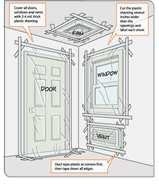Staying Put

Click here to view Shelter-In-Place diagram.
Whether you are at home, work or elsewhere, there may be situations when it's simply best to stay where you are and avoid any uncertainty outside.
There are other circumstances when staying put and creating a barrier between yourself and potentially contaminated air outside, a process known as "sealing the room," is a matter of survival. Use available information to assess the situation. If you see large amounts of debris in the air, or if local authorities say the air is badly contaminated, you may want to take this kind of action.
The process used to seal the room is considered a temporary protective measure to create a barrier between you and potentially contaminated air outside. It is a type of sheltering in place that requires preplanning.
To "Shelter in Place and Seal the Room"
- Bring your family and pets inside.
- Lock doors, close windows, air vents and fireplace dampers.
- Turn off fans, air conditioning and forced air heating systems.
- Take your emergency supply kit unless you have reason to believe it has been contaminated.
- Go into an interior room with few windows, if possible.
- Seal all windows, doors and air vents with plastic sheeting and duct tape. Consider measuring and cutting the sheeting in advance to save time.
- Be prepared to improvise and use what you have on hand to seal gaps so that you create a barrier between yourself and any contamination.
- Local authorities may not immediately be able to provide information on what is happening and what you should do. However, you should watch TV, listen to the radio or check the Internet often for official news and instructions as they become available.
Learn how and when to turn off utilities:
If there is damage to your home or you are instructed to turn off your utilities:
- Locate the electric, gas and water shut-off valves.
- Keep necessary tools near gas and water shut-off valves.
- Teach family members how to turn off utilities.
- If you turn the gas off, a professional must turn it back on. Do not attempt to do this yourself.





